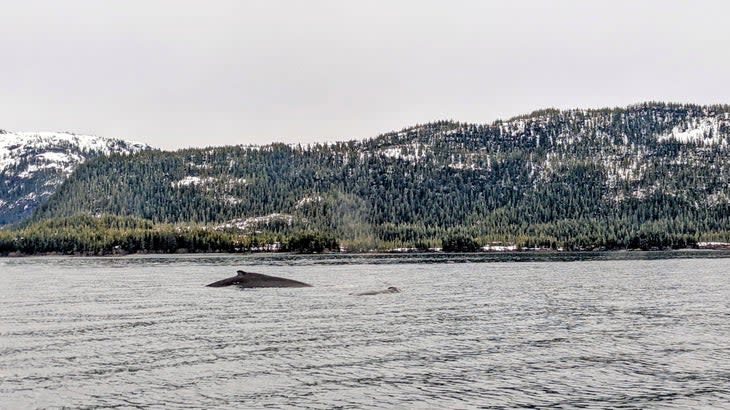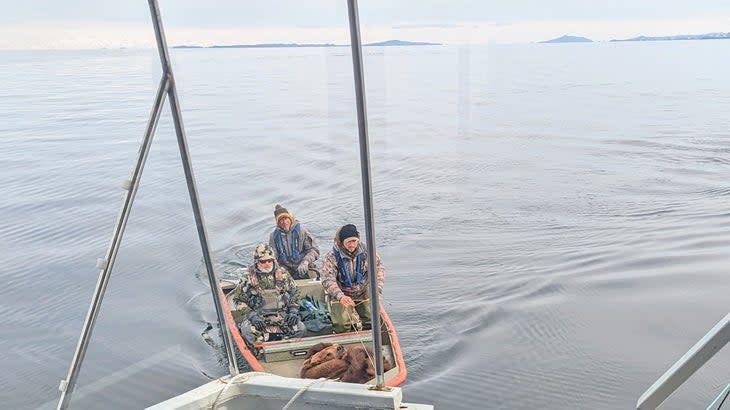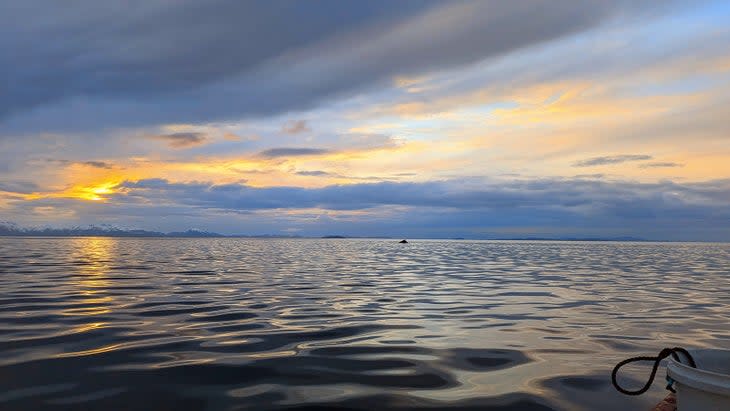Why You Shouldn’t Be Outraged By Trophy Hunting
This article originally appeared on Outside
Hunting is the reason we have such abundant populations of wild animals in North America. But, the act itself--killing animals for sport--remains controversial, often attracting vitriol, and even death threats from non-hunters who claim to care about those wild animals. Because that ignorance actually threatens the future of wildlife conservation, it's important to educate the general public about its benefits. This is my attempt to do that, from the perspective of a trophy hunter.
This May, my wife and I visited Alaska to hunt Peninsula Brown Bear, and were successful. Upon returning to to port, I posted a picture of that bear and deliberately left it free of context in order to collect readers' unvarnished reactions. I'll avoid embedding the photo here since it contains a dead bear, but you can check it out here to read those reactions yourself. I think they're a good illustration of why this explanation is necessary.
What Is Sport Hunting?
As European settlers spread westward during the 18th and 19th centuries, they brought with them towns, cities, roads, railroads, and industrial agriculture. These factors, plus unregulated hunting, decimated populations of our continent’s wild animals.
Seeing the devastation, influential animal lovers like Theodore Roosevelt, Aldo Leopold, William Temple Hornady, and many others set about looking for a solution. The result was the modern conservation movement.
"The nation behaves well if it treats the natural resources as assets which it must turn over to the next generation increased and not impaired in value," Roosevelt told the Colorado Livestock Association in 1910. "Conservation means development as much as it does protection."
Conservation is the managed use of resources, with the goal of protecting and improving them for the enjoyment and profit of future generations. The movement recognized that, in order to continue to exist in our human world, an economic value needed to be attached to the protection of wild places and wild animals.
The way this idea is applied to the protection of wild animals is known as the North American Model of Wildlife Conservation. It works by making the population health of wild animal species a subject of significant scientific study, then charges hunters and anglers fees that pay for that both that science, and the protection of animal habitats. Taxes on hunting and fishing equipment along with license and tag fees are what funds wildlife management agencies and pays for the protection of public land, and those hunters and anglers then perform the hard work of population management based on the best possible science funded by those taxes and fees.
Like any broad-reaching system of policies and science, this one is imperfect. But it's hard to argue with the results. Between the 1930s and today--a time in which the human population on this continent tripled--the number of waterfowl grew from a low of 27 million, to 50 million ducks, geese and similar birds. In 1914, there were only 41,000 elk left in North America. Today there's more than one million. In 1940, there were less than 200,000 wild turkeys. Now there's six million. The nationwide population of deer grew from about half a million to 30 million in just a single century.
The taxes generated by hunters and anglers have netted $25.5 billion for wildlife and habitat conservation since 1937. Last year alone, taxes levied specifically on hunters and anglers paid $1.5 billion to state wildlife programs.
North America’s system works differently than that of other continents. (Interested in learning how trophy hunting benefits animal populations in Africa? I explained that in this article.)

How Hunting Bears Protects Their Population Health
The last grizzly bear in California--a state whose flag shows the animal--was shot in 1922. The bears once roamed as far south as central Mexico and as far east as the Mississippi River. But enormous apex predators don't get along well with human civilization. Today, several hundred grizzly bears exist in isolated populations in the Northern Rockies, the Greater Yellowstone Ecosystem, and in the North Cascades, where they frequently run into conflicts with campers, ranchers, and railroads. Brown bears in the lower 48 currently enjoy protections under the Endangered Species Act, and can't be hunted.
It doesn't matter where you are in the world, all brown bears are the same species. Here in North America, we call brown bears that live inland Grizzly Bears. They tend to be smaller than their cousins in coastal Alaska, where the Alaska Peninsula Brown Bear grows huge on a diet full of wild salmon.
About 30,000 brown bears live in Alaska, a number that's remained steady since counting them began in the 1930s. In that same time, Alaska's population of humans grew from about 59,000 to over 732,000.
Brown bear populations in southeast Alaska are threatened by two things: logging and road construction. Roads are constructed through the Alaskan wilderness to facilitate timber harvests. Logging destroys habitat, and roads bring humans into places where brown bears live. When the two species meet, things do not typically go well. Between 1986 and 1996, 677 bears were killed by humans outside of deliberate hunts.
In the United States, federally-managed public lands like National Forests are run according to the principal of multiple use. The needs of all users, including resource extraction and wildlife conservation, must be given equal priority in management agency decision making. Alaska's hunter-funded Board of Game ensures the protection of bear habitat is considered when the USFS and state agencies make decisions about timber extraction locations.
Those bears live on increasingly isolated peninsulas and islands in coastal southeast Alaska, cut off from each other by encroaching human activity. Brown bears are territorial--dominant males not only prevent other males from mating with females in their territory, but also kill the cubs of rival males, all to preserve their own genetic lineage. In isolated habitat, that means a small number of mature males can dominate local gene pools, breeding with their own offspring and limiting genetic diversity. This can make populations less able to adapt to changes in their environment. And right now, the environment brown bears live in is changing drastically due to climate change. For example, warmer, less predictable weather is reducing the abundance of both wild berries and salmon--both critical food sources for the bears.
To foster genetic diversity in these isolated populations, Alaska's Board of Game conducts regular population surveys, then determines the number of mature males that need to be removed from those populations annually to allow younger males to disperse and find new mates. That's what determines the number of hunting tags throughout different areas of southeast Alaska, where the bears are hunted. Hunters then spend large sums of money in order to perform the work of removing that set number of mature males from those specific populations, and that money goes back into funding the wildlife science and protecting habitat.

Why Photo Tourism Can't Replace Hunting
A very small number of hunters spend large sums of money and require very little infrastructure. In fact, the best hunts often take place in the most austere environments. A large number of photo tourists spend much less on items, travel, and services that aren't specifically taxed in benefit of wildlife conservation, and those crowds require roads, viewing platforms, restaurants, and hotels. Hunters attempt to minimize their impact across vast areas. Tourism puts pressure on a small number of heavily visited places.
The area in which we hunted bear this May is roughly equivalent in size to the entire state of Massachusetts. Alaska issues six total brown bear hunting permits for that entire region, all serviced by the same outfitter. That outfitter took two 12-day trips with three hunters apiece to that area. The hunters slept on boats, and barely set foot on land in order to avoid disturbing the bears.
Compare that to popular bear viewing areas on nearby Kodiak Island, which is half the size. 64,000 people travel there each year to see bears, about half of whom arrive on cruise ships. Most of those people view bears at a small handful of developed viewing sites.
Those tens of thousands of Kodiak tourists are looking at same few bears over and over. Each hunter is looking for a single mature male, which only they will hunt. Tourism focuses its economic impact on a tiny fraction of bear habitat, and the activity does not work in benefit of the species. Hunting spreads its money across the entirety of brown bear habitat, and provides the tools for science-based management.

Addressing Common Trophy Hunting Objections
As evidenced in the comments on my Instagram post from the hunt, casual animal lovers have numerous misconceptions about trophy hunting. I'm going to condense those into five general areas.
"Killing for food is more ethical than killing for a trophy."
I don't think that matters to the animal, once you've shot it. The purpose of hunting is to help conserve wild animals. Any other benefit, including tasty food, is secondary to that. Hunting bears in spring means hunting bears just out of hibernation, and bears taste like what they're eating. In coastal Alaska, with snow still down to the beach, that means easy protein sources like the rotten carcasses of seals that washed up over the winter. Bears are also the number one vector through which humans contract Trichinellosis. Most brown bear hunters bring home the trophy, not the meat.
"Why take photos with a dead animal?"
Hunts are really hard to photograph. Animals are typically first spotted at great distance through binoculars and spotting scopes, and then approached as stealthily as possible. Before spotting the bear I eventually shot, we only saw two others. While stalking the first, we lost sight of him at several hundred yards--way beyond photo distance for anyone but a well-equipped professional photographer--and then didn't catch sight of him again until he winded us at 30 yards, and charged right past us at close range. I wasn't thinking about pulling my smartphone out of my pocket during that instant. Nor did the thought occur to me while I was jumping out of a skiff in heavy surf, climbing a sharp, slippery rock, and aiming my rifle at the bear I eventually shot. And even if I had taken the time to snap a photo, the bear would have looked like nothing but a black spec at that distance. But I still wanted to take home memories of the hunt, so I took a picture with the bear once he was down.
"Using [insert weapon here] is too easy."
Believe me, I get what a problematic symbol guns are in today's society. But if you've never shot one, using a rifle under pressure to place an exact shot inside an animal's critical organs during a fleeting opportunity in a dynamic environment is not as easy at it might sound. I began learning to shoot back in Boy Scouts when I was 10, and have continued to try and perfect the craft ever since. 32 years of practice paid off. Even with an elevated heart rate and an unstable rest atop a sharp, slimy, wet rock, I was able to put a bullet through both lungs and the heart of a bear from 220 yards away. He ran about 10 yards into some trees before collapsing, and died on the spot. I'm proud that I was able to give such a majestic animal the quickest, most humane death possible.
And nothing is ever guaranteed in hunting, even when things get expensive. Guides are mandatory for out-of-state hunters pursuing brown bear in Alaska. Field judging sex and maturity can be difficult, and this also helps keep hunters safe. As with dangerous game in Africa, the guide backs up the hunter with their own gun, both to prevent the animal from attacking the hunter, and to ensure a wounded animal is quickly dispatched. Of the two other hunters on the trip with us, one worked with his guide to put nine follow up shots into his bear before it dropped, and the other never got a single shot at a bear at all.
"Management should be handled by professionals."
One reader argues that, if the purpose of hunting is conservation, then when an animal needs to be removed from a population, that work should be performed only by trained professionals. This actually happens. Wildlife Services, a division of the United States Department of Agriculture, killed 1.75 million wild animals in 2021. All of those deaths came at a net cost to taxpayers, and in order to conduct them as cheaply as possible, many of them involved inhumane methods like poisoning, or shooting from aircraft (where accurate shots are essentially impossible). In contrast, hunting involves a net benefit to taxpayers, since hunters are paying specific taxes and fees in order to participate in conservation, which then protect the public lands we all enjoy.
"Hunting the largest animals removes the best genes."
Pursuing mature males, and attempting to find the oldest and most physically impressive examples of a given species means you're pursuing animals who have already bred for multiple seasons. Their genes have already been spread, and allowing younger males to breed in that area fosters genetic diversity. It's total population health, not narrow lineages, that then continues to produce not only the most impressive animals, but the most powerful conservation benefits too. The largest brown bear ever shot with archery equipment was taken in 2018.

Why Hunt?
A month ago, I was able to watch two grizzly cubs frolic in light from the Buck Moon, at close distance. It was easily the second neatest experience I've ever had with wildlife, after this bear hunt. You see, I'm fascinated with the species, and spend a lot of my time seeking out opportunities to view them or learn about them in the wild. And the logical result of that is a desire to help the species continue to exist, even as our own species slowly destroys the natural world. Hunting one is the culmination of decades of interest, and the most powerful contribution I can personally make to their conservation. And thanks to the rug I'm having made, it's also a contribution I'll be able to remember, and share with my friends and family for years to come. Even when I'm not out in the woods looking for bears, I'll have one right here in my living room reminding me that I've done my best to ensure there'll be plenty of bears out there for future generations.
For exclusive access to all of our fitness, gear, adventure, and travel stories, plus discounts on trips, events, and gear, sign up for Outside+ today.

